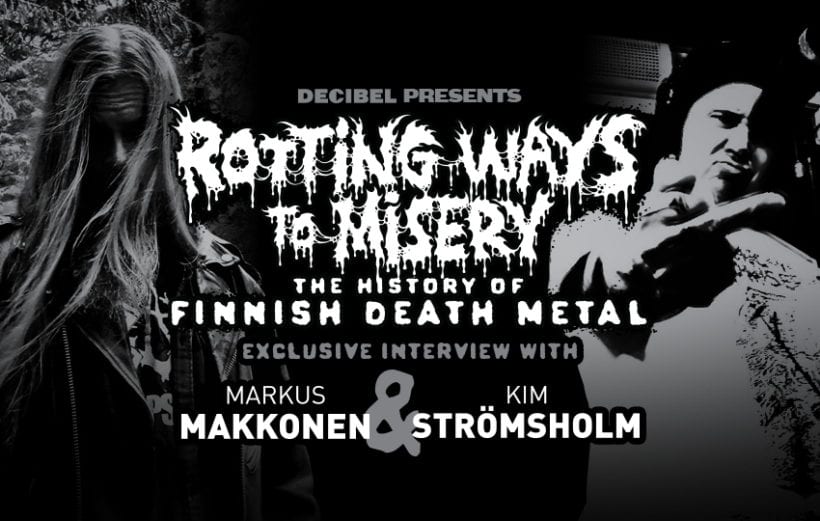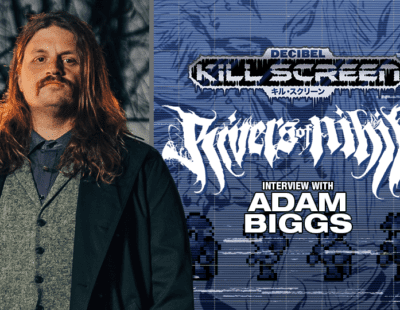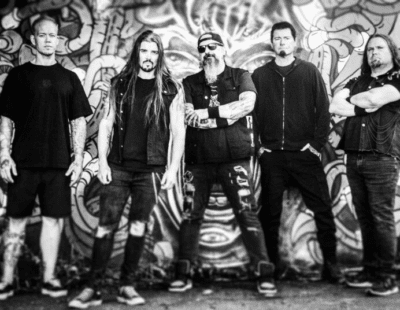
It’s not talked about as much as Sweden or the USA, but Finland has a strong death metal history, a fact not lost on Markus Makkonen and Kim Strömsholm. Indeed, the two wrote a book, Rotting Ways to Misery: The History of Finnish Death Metal, on the country’s rich DM past, and now Decibel Books is proud to present the North American release of Rotting Ways as a 364-page hardcover, limited to 1,000 copies.
Totally redesigned and edited, the book looks at the extreme metal and thrash scenes in Finland in the late ’80s, the short-lived DM boom of the ’90s and the resurgence of the scene from a new crop of young longhairs.
“Finnish death metal did die once in the history, but luckily it refused to remain buried,” says Makkonen. “So, today we have three generations of it available. The pioneers, some of them still going, the bands that brought it back 10-15 years ago and the new kids in gore town, who are releasing potent demos right now. I hope as many people as possible into such a thing would discover these bands as they deserve to be heard.”
We caught up with the two authors to talk Finnish DM shop—read our interview below, and order Rotting Ways to Misery: The History of Finnish Death Metal here. And while you’re at it, for a soundtrack to all this, check out the playlist that Makkonen and Strömsholm guest curated for us at our Apple Music page here.

Why did you decide to write this book in the first place?
Kim Strömsholm: When I was around 14-15, I had an idea of writing three books when the time is right, this one being the second one in line. I think the idea of doing a book about death metal came up around 2015 when we reformed Festerday. Not long [after] that I heard Markus was working on a similar book project. We had a short discussions around the theme itself and decided to collaborate instead of writing two books about the same topic.
Markus Makkonen: Yes. That’s how it went. For years and years I was hoping somebody would pick up the subject and write down the stories I felt deserved to be told. Still, nothing happened. Around 2015, the toying around the idea of writing it by myself—if no one else was going to—started to be a regular thing and eventually Luxi Lahtinen, the grand old man of Finnish death metal, tireless promoter, cover artist and an active all-around man since day one, convinced me on getting started with it. Not too long after, Kim got in contact and here we are now, with a finished book.
Why does Finnish death metal deserve its own book?
Strömsholm: I’d say because of its diversity and unpolished, unique sound, but also the amount of bands in a small country like Finland; the scene was stuffed with original death metal in an early stage. People used to talk about the Swedish sound or Florida death metal, but Finnish death metal was very different from these due to the exclusive sound and approach to the music.
Makkonen: Yeah, and due [to] the fact [that] Finnish death metal was always on small underground labels, the main core of the story has remained untold. Or not gathered in one place, at least. Finnish bands were not included in the previous books about this particular musical direction and the main line of the story from here has never been collected into one chronological piece.
How did the Decibel reprint of this book come about?
Strömsholm: Not really sure how, but either Decibel was in contact with Cult Never Dies or vice versa, but through that discussion the reprint came to be, and to us it sounded like a great idea.
Makkonen: Cult Never Dies got involved with the project some years ago and with them, the book settled in the stylistic conclusion it has now, as a finished product. At some point, they approached us about the possible Decibel version and wanted to know our thoughts about it, and our response was of course pretty enthusiastic, of course.
Is this book for casual metalheads or diehard death metal fans?
Strömsholm: I would say both. Its core is more in the underground, but I suppose many casual metalheads would love to read about the history of bands such as Amorphis, Sentenced…
Makkonen: Agreed. It focuses on a phenomenon that was 100 percent an underground movement. A die-hard cult, if you will. Then again, our primary goal was to be as informative as possible, to a point where any music fan (or at least any metal music fan), could read it and learn from it, even without knowing a single thing about Finnish death metal itself.
What do you want people to know about Finnish death metal?
Strömsholm: By reading this book you’ll know pretty much everything about Finnish death metal: how and where it started, who were the progenitors and how it all developed into a dead scene until the younger generation reformed the underground to this day.
Makkonen: We wanted to underline the overall atmosphere of that particular era in the country (as it was a lot different to what it is now) and bring forth the thoughts and ideas the kids (and by this I mean kids!) coming up with these groundbreaking songs were going through, while forming their bands and getting their demos out. Basically, like Kim said, we would like to people to paint a thorough big picture of the whole early movement from the dawn of it, to its abrupt downfall and demise.
What is, in your opinions, the most essential Finnish death metal album of all time and why?
Strömsholm: Shit. To name just one is hard, but to me it is either Xysma’s Yeah (the debut release was not a full album) or Nespithe by Demilich.
Makkonen: Top calls! Xysma was the first there ever was, as far as the full albums went, and both of these records are one-of-a-kind releases, still today. Besides these, I would maybe like to add From the Shadows by Unholy to the list of the very best and essential.






